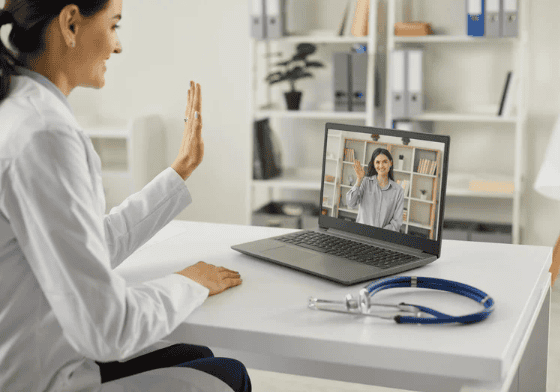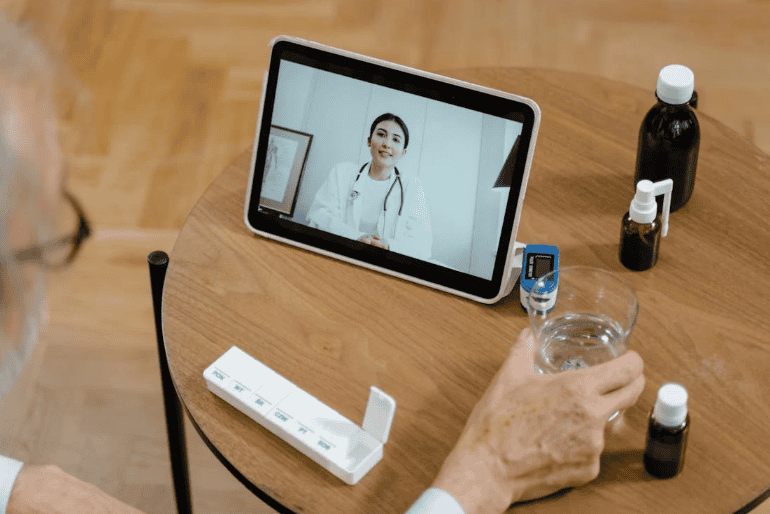Healthcare providers adopting a virtual consultation app discover a powerful tool for strengthening patient relationships and improving clinical outcomes.
The technology bridges communication gaps between appointments while creating more accessible healthcare experiences for diverse patient populations. Implementing these digital solutions enables providers to meet growing patient expectations for convenience while maintaining high-quality care standards.
Let’s explore the core advantages these platforms offer to modernize patient engagement strategies and enhance the overall healthcare experience.

Enhanced Accessibility and Convenience
Virtual consultation platforms dramatically improve healthcare accessibility by removing traditional barriers to care. These solutions create flexible access points that accommodate diverse patient needs and circumstances.
Patients living in rural areas or with limited transportation options gain particular advantages from virtual access. Rather than traveling hours for a brief follow-up appointment, they can connect with providers from home, saving time, reducing stress, and eliminating transportation costs.
Such convenience proves especially valuable for patients with mobility challenges, chronic conditions requiring frequent check-ins, or those balancing healthcare needs with demanding work schedules.
The asynchronous communication features found in many virtual consultation applications further enhance convenience. Patients can submit questions or concerns outside office hours and receive responses when providers become available.
The most noticeable benefit to this approach is the reduced pressure to address every issue during limited appointment windows while creating continuous engagement between scheduled visits.
Improved Patient Communication and Education
Effective patient education is critical to successful treatment adherence and outcomes. Virtual consultation tools provide multiple channels for delivering personalized educational content that reinforces treatment plans and preventive care guidance.
Through these platforms, you can share tailored educational resources, including:
- condition-specific information with interactive elements
- medication administration tutorials with visual demonstrations
- lifestyle modification guidance with practical implementation strategies
- preventive care recommendations based on individual risk factors
- post-procedure care instructions with progress tracking tools
The digital format allows patients to review materials repeatedly at their convenience, reinforcing understanding and retention. Many platforms support multimedia content, combining text, images, and videos to accommodate different learning preferences and health literacy levels.
These tools also facilitate more consistent communication through automated check-ins and educational touchpoints. Strategically timed messages reinforce key information, remind patients about important self-care tasks, and maintain engagement with treatment plans between appointments.
Streamlined Administrative Processes
Administrative inefficiencies create significant friction in the patient experience. Virtual consultation applications address these pain points by automating routine tasks and creating more intuitive patient workflows.
Digital intake forms eliminate redundant paperwork while improving data accuracy. Patients complete forms before appointments, reducing waiting room time and allowing providers to review information before encounters begin. This preparation enhances appointment efficiency and quality.
Appointment scheduling features reduce administrative phone calls while giving patients greater control over their healthcare experience. Self-scheduling options through secure portals allow patients to view available times and select options that fit their schedules without staff assistance. Automated reminders then reduce no-show rates and improve practice efficiency.
Secure messaging capabilities streamline routine communications like prescription refill requests, basic questions, and non-urgent concerns. This communication channel reduces phone tag frustration for patients and staff while creating documented conversation records for future reference.

Real-Time Health Monitoring and Management
Remote monitoring capabilities integrated with virtual consultation platforms create unprecedented opportunities for proactive health management. These tools transform episodic care into continuous health partnerships between patients and providers.
Many applications now support integrating patient-owned devices like blood pressure monitors, glucose meters, and activity trackers. This connectivity allows patients to share vital health data directly with their care team, enabling earlier intervention when concerning trends emerge. Providers can establish personalized parameters for each patient, receiving alerts when readings fall outside expected ranges.
For patients managing chronic conditions, these monitoring features prove to be vital. Diabetes management, for example, benefits significantly from continuous glucose monitoring with provider oversight. Hypertension management similarly improves through regular blood pressure reporting and medication adherence tracking.
Combining monitoring capabilities with virtual consultation creates a comprehensive remote care ecosystem. When concerning data appears, providers can immediately initiate a virtual check-in to assess the situation and make necessary adjustments, often preventing complications that might otherwise require emergency intervention.
Enhanced Patient Satisfaction and Loyalty
Patient expectations continue evolving based on digital experiences in other sectors. Virtual consultation platforms help healthcare organizations meet these expectations while building stronger patient relationships.
Modern patients increasingly value convenience, transparency, and personalization in their healthcare experiences. Digital tools deliver these elements through features like on-demand scheduling, clear communication channels, and customized health information. Meeting these expectations translates directly to higher satisfaction scores and improved patient retention.
The engagement data captured through virtual platforms also provides valuable insights for continuous practice improvement. You can analyze which educational resources prove most effective, identify common patient questions that might benefit from proactive addressing, and recognize patterns in appointment scheduling that could inform staffing decisions.
When implementing these solutions, prioritize platforms that balance technological sophistication with user-friendly design. The most advanced features provide little value if patients struggle to navigate the interface. Look for solutions that offer intuitive navigation, clear instructions, and accessible support resources for users of all technical skill levels.
Conclusion
Virtual consultation applications substantially benefit healthcare organizations seeking to enhance patient engagement while improving operational efficiency. With their ability to provide convenient access, personalized education, streamlined administrative processes, and continuous monitoring, these platforms transform traditional healthcare delivery models into more responsive, patient-centered systems.
Organizations that thoughtfully implement these technologies establish themselves as preferred providers, delivering care experiences that blend clinical excellence with digital convenience.


